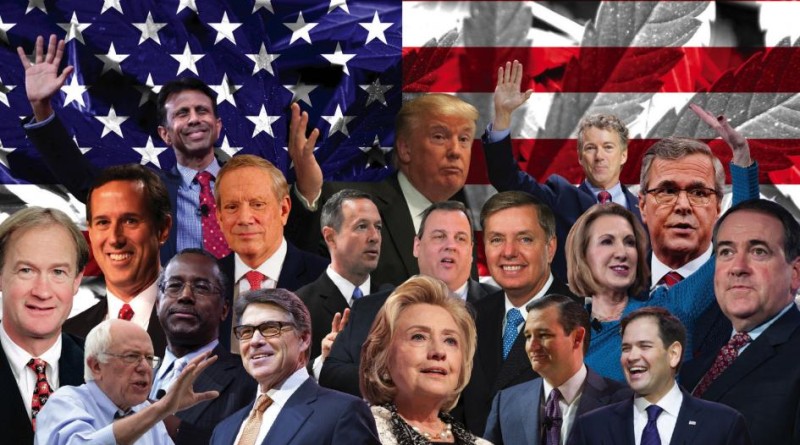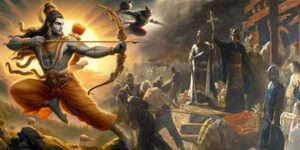The 2016 American Presidential election currently has a large number of candidates on the Republican side, and a remarkable battle between two candidates on the Democratic side. Rather than endorsing any of the candidates, I want to take a look at some of the essential political background, especially from the point of view of Sanatana Dharma, and also in light of the different political spectra of the United States of America and of India.
To know the truth of a thing, we usually have to look beyond the surface, and to know the truth of two or more things, we have to look beyond superficial similarities. In the politics of the United States and of India, this is especially true, and particularly for those of us who try to keep a dharmic perspective. Why these two countries in particular?
On one hand, I am writing for a website (MyIndMakers) that focuses on these two important democracies as bearers of civilization; and specifically in regard to the 2016 elections. On the other hand, there are, alongside significant differences, important similarities between the two nations. In light of this, comparing and contrasting the political spectra is essential for proper understanding.
Most readers will know the basic history of both countries – they are each former colonies of the then-British Empire, whose current political systems were strongly influenced by those of the Empire. India is, regardless of long periods of foreign rule, one of the major classical civilizations of the world, and out of those of the Indo-European family, the only one to have kept its own culture and identity, rather than succumbing to subversion and heavy fusion with hostile cultures at best.
In contrast to that, the United States of America is a relatively young nation, predominantly foreign in nature, since it continues to mostly ignore and suppress the indigenous civilization; and with a heavily Christianized population of European descent, comes primarily from people who did lose large parts of their culture to Middle Eastern influence where India withstood it.
Another aspect of history is important here: the origin of the “left-wing”/” right-wing” political terminology. My understanding is that it primarily comes from the French Parliament of centuries ago, and was adapted later to Britain, and to other European and Western countries. Although differing from place to place, these categories had to do with the socio-economic classes of those countries, and the economic and social ideologies that they tended to favor.
The political spectra of the two nations are a prime example of the danger of not looking beyond superficial similarities. Each has a spectrum of ideologies and parties that are categorized on a range between poles called “right wing” and “left wing”, of which the left-wing has as its extreme communist and socialist groups, and the right-wing has an extreme of classist, racist, religious fanatics. This much is true, to the best of my knowledge and understanding.
Yet there is a major problem that misleads many – namely, the group that comprises India’s right-wing is not identified as such, and that label is incorrectly applied to another segment of the population. This, in turn, leads some people to lend political support to those who are not actually favorable to them.
In the United States, the extreme right-wing is, among other things, influenced to the extent of considerable control by the form of Christianity known as Fundamentalism. This is an extremist wing of ‘evangelical’ or ‘born-again’ Christianity. Many Fundamentalists share a political ideology known as Dominionism, which mistakenly believes that the US was founded as a ‘Christian nation’, and seeks to ‘restore’ it to being a Fundamentalist theocracy.
In India, “right-wing” is commonly applied to those political parties and ideologies that support the majority, indigenous Hindu culture and its identity as inherent to India. This is simply inaccurate and untrue, since the values of Hindu civilization are quite different from those of Fundamentalists, as well as from other, earlier Western versions of the right-wing.
Keeping in the mind the original of “right-wing” and “left-wing”, the reality is that those categories and Hindu civilization are mostly irrelevant to each other. Seen in its true place, Hindu civilization, and dharmic views in general, are not even on the same scale as the right-wing and left-wing, but could be called transcendental to it. However, since the wing spectrum is the standard political terminology, it makes sense to try to place Hindu parties on the spectrum according to where its various concepts and ideals seem to be fit.
Even if one accepts the notion of calling the Hindu-oriented parties of India as ‘right-wing’, it is very important to realize that this does not make them equivalent to or compatible with Western right-wings. The American right-wing, in particular, is strongly influenced, even controlled, by Fundamentalist Christians, as well as in some areas, by Mormons. These are the same groups responsible for the missionary subversion that is so troublesome in India, even to the extent of terrorist separatist movements in the Northeast.
I would argue that the true ‘right-wing” in India is comprised of hardline Muslims and Christians, corresponding closely to the American right-wing. Hindu parties are actually in the center of the spectrum, as the closest approximation to the more accurate position of being transcendental to that spectrum.
For those of us who value dharma, it makes much more sense to look at politics through a dharmic lens, rather than the internal struggles of early modern France and the political spectrum based on them. In particular, Sanatana Dharma gives us a social organization of four occupational classes, which in Bhagavad-Gita are described in close connection to particular psychological traits.
The original French political split was between the nobility (from dharmic perspective, highly corrupted quasi-Kshatriya-like people) and ‘commoners’. The more modern left-wing, right-wing split, especially in the United States, can be seen as a class war between supporters of rule by Vaishya’s (unrestrained capitalism, for example), and supporters of rule by shudras (socialism and communism, for example), and moderate manifestations of each. Dharmically, they are both illegitimate, because neither class has traits conducive for providing good government. We need to consider the qualities of each class, therefore.
In the Gita, Lord Krishna lists the qualities that define each class and its members; they can be distilled to the basic motivations of each class, which makes their political utility clear. The Brahmana-type is particularly motivated to seek truth and knowledge above all else, and to share it. There is a quote from a European philosopher named Erasmus that exemplifies this drive: “When I have a little money, I buy books. When I have a little more money, I buy food.” Next, there is the Kshatriya-type, whose nature is to protect and lead. Among other things, a proper Kshatriya is willing to sacrifice himself or herself to protect others from harm, if necessary; and they prize honor and integrity and generosity.
The Vaishya-type has the primary motivation of seeking wealth. Good ones do it honestly and in turn generously share it, as well as in a properly-dharmic society, providing most of the tax revenue. Bad ones are incredibly dangerous, as they put their profit above the wellbeing of people and other living things. Finally, the shudra class primarily seeks personal security and stability, working for others, in the other classes, for their livelihood. Working together, in harmony, these four classes create a mutually-beneficial civilization.
As dharmis, then, really we should be very leery of any ideology that is based on championing one class over all the others, or against any of them. Dharma itself is an ideal political ideology, when seen from the political perspective.
The American right-wing is flawed, in that perspective, by championing the vaishya in particular, and viewing the shudra as an expendable resource that should be proud to suffer in the process of making the vaishya richer.
The left-wing, in its extreme manifestations, is flawed by seeking to either eliminate or control all the non-shudras. Meanwhile, history shows us many examples around the world, of what happens when Kshatriya- and Brahmana-types go bad, and become oppressive, leading to theocracies and tyrannies.
Where does all this leave us, in regard to the elections later this year? As I said at the outset, I am not here to endorse anyone, but rather to try to give some background to help in making dharmic choices.
On the basis of that information, I would suggest the following: (1) avoid supporting anyone whose ideology is extremist, and particularly non-dharmic or anti-dharmic. (2) Try to determine the policies favored by the candidates, and see whether they really work for the benefit of all, or if they run counter to a good balance and harmony in society.
Dharma is both a high ideal, and extremely practical, and likewise good political leadership should have high ideals and practical ways to achieve or at least work toward them. A good leader needs knowledge, wisdom, justice, mercy, integrity, and awareness, among other things. A bad leader may be seen by things like ignorance, lack of integrity, cruelty, seeing others are expendable, paranoia, and predatory, as well as encouraging these things in followers. In democracies, it is the duty of citizens to exercise our own best qualities in voting wisely, particularly in trying to choose the best leaders. Let us all try to do this, with care and attention.
By Mark DeFillo






























